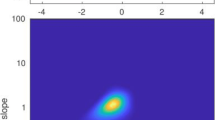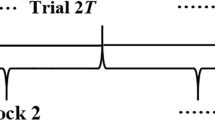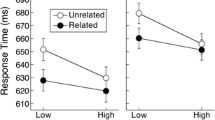Abstract
The power function is treated as the law relating response time to practice trials. However, the evidence for a power law is flawed, because it is based on averaged data. We report a survey that assessed the form of the practice function for individual learners and learning conditions in paradigms that have shaped theories of skill acquisition. We fit power and exponential functions to 40 sets of data representing 7,910 learning series from 475 subjects in 24 experiments. The exponential function fit better than the power function in all the unaveraged data sets. Averaging produced a bias in favor of the power function. A new practice function based on the exponential, the APEX function, fit better than a power function with an extra, preexperimental practice parameter. Clearly, the best candidate for the law of practice is the exponential or APEX function, not the generally accepted power function. The theoretical implications are discussed.
Article PDF
Similar content being viewed by others
Explore related subjects
Discover the latest articles and news from researchers in related subjects, suggested using machine learning.Avoid common mistakes on your manuscript.
References
Anderson, J. R. (1982). Acquisition of cognitive skill.Psychological Review,89, 369–406.
Anderson, J. R., Fincham, J. M., &Douglass, S. (1997). The role of examples and rules in the acquisition of a cognitive skill.Journal of Experimental Psychology: Learning, Memory, & Cognition,23, 932–945.
Anderson, J. R., Fincham, J. M., &Douglass, S. (1999). Practice and retention: A unifying analysis.Journal of Experimental Psychology: Learning, Memory, & Cognition,25, 1120–1136.
Anderson, J. R., &Schooler, L. J. (1991). Reflections of the environment in memory.Psychological Science,2, 396–408.
Anderson, R. B., &Tweney, R. D. (1997). Artifactual power curves in forgetting.Memory & Cognition,25, 724–730.
Azzalini, A., Bowman, A. W., &Hardle, W. (1989). On the use of nonparametric regression for model checking.Biometrika,76, 1–11.
Bates, D. M., &Watts, D. G. (1988).Nonlinear regression analysis and its applications. New York: Wiley.
Box, G. E. P., &Cox, D. R. (1964). An analysis of transformations.Journal of the Royal Statistical Society B,26, 211–246.
Brown, S., &Heathcote, A. (1997). [The law of practice for four choice RT]. Unpublished experiment. Callaghan, Australia: University of Newcastle.
Brown, S., &Heathcote, A. (2000).Fitting nonlinear models to averaged data. Manuscript submitted for publication.
Carrasco, M., Ponte, D., Rechea, C., &Sampedro, M. J. (1998). “Transient structures”: The effects of practice and distractor grouping on within-dimension conjunction searches.Perception & Psychophysics,60, 1243–1258.
Carroll, R. J., &Ruppert, D. (1988).Transformation and weighting in regression. New York: Chapman and Hall.
Cohen, J., Dunbar, D. K., &McClelland, J. L. (1990). On the control of automatic processes: A parallel distributed processing account of the Stroop effect.Psychological Review,97, 332–361.
Colonius, H. (1995). The instance theory of automaticity: Why the Weibull?Psychological Review,102, 744–750.
Delaney, P. F., Reder, L. M., Staszewski, J. J., &Ritter, F. E. (1998). The strategy-specific nature of improvement: The power law applies by strategy within task.Psychological Science,9, 1–7.
Estes, K. W. (1956). The problem of inference from curves based on group data.Psychological Bulletin,53, 134–140.
Heathcote, A. (1990).Learned pop-out in search for relative position. Unpublished doctoral dissertation, Queen’s University, Kingston, Ontario, Canada.
Heathcote, A.,Brown, S., &Mewhort, D. J. K. (2000).Nonlinear regression for response time data. Manuscript in preparation.
Heathcote, A., &Mewhort, D. J. K. (1993). Selection and representation of relative position.Journal of Experimental Psychology: Human Perception & Performance,19, 448–515.
Heathcote, A., &Mewhort, D. J. K. (1995, November).The law of practice. Poster presented at the 36th Annual Meeting of the Psychonomic Society, Los Angeles.
Josephs, R. A., Silvera, D. H., &Giesler, R. B. (1996). The learning curve as a metacognitive tool.Journal of Experimental Psychology: Learning, Memory, & Cognition,22, 510–524.
Kail, R., &Park, Y.-S. (1990). Impact of practice on speed of mental rotation.Journal of Experimental Child Psychology,49, 227–244.
Kirsner, K., &Speelman, C. (1996). Skill acquisition and repetition priming: One principle, many processes?Journal of Experimental Psychology: Learning, Memory, & Cognition,22, 563–575.
Kling, J. W. (1971). Learning: An introductory survey. In J. W. Kling & L. A. Riggs (Eds.),Woodworth and Schlosberg’s Experimental psychology (pp. 551–613). New York: Holt, Rinehart & Winston.
Kramer, A. F., Strayer, D. L., &Buckley, J. (1990). Development and transfer of automatic processing.Journal of Experimental Psychology: Human Perception & Performance,16, 505–522.
Logan, G. D. (1988). Toward an instance theory of automatization.Psychological Review,95, 492–527.
Logan, G. D. (1992). Shapes of reaction-time distributions and shapes of learning curves: A test of the instance theory of automaticity.Journal of Experimental Psychology: Learning, Memory, & Cognition,18, 883–914.
Logan, G. D. (1995). The Weibull distribution, the power law, and the instance theory of automaticity.Psychological Review,102, 751–756.
Luce, R. D. (1986).Response times. New York: Oxford University Press.
MacKay, D. (1982). The problems of flexibility, fluency, and speed-accuracy trade-off in skilled behavior.Psychological Review,89, 481–506.
Mazur, J. E., &Hastie, R. (1978). Learning as accumulation: A reexamination of the learning curve.Psychological Bulletin,85, 1256–1274.
Miller, D. M. (1984). Reducing transformation bias in curve fitting.American Statistician,38, 124–126.
Myung, I. J.,Kim, C., &Pitt, M. A. (in press). Toward an explanation of the power law artifact: Insights from a response surface analysis.Memory & Cognition.
Neves, D. M., &Anderson, J. R. (1981). Knowledge compilation: Mechanisms for the automatization of cognitive skills. In J. R. Anderson (Ed.),Cognitive skills and their acquisition (pp. 1–55). Hillsdale, NJ: Erlbaum.
Newell, A. (1973). You can’t play 20 questions with nature and win: Projective comments on the papers of this symposium. In W. G. Chase (Ed.),Visual information processing (pp. 283–308). New York: Academic Press.
Newell, A., &Rosenbloom, P. S. (1981). Mechanisms of skill acquisition and the law of practice. In J. R. Anderson (Ed.),Cognitive skills and their acquisition (pp. 1–55). Hillsdale, NJ: Erlbaum.
Nosofsky, R. M., &Palmeri, T. J. (1997). An exemplar-based randomwalk model of speeded classification.Psychological Review,104, 266–300.
Palmeri, T. J. (1997). Exemplar similarity and the development of automaticity.Journal of Experimental Psychology: Learning, Memory, & Cognition,23, 324–354.
Press, W. H., Flannery, B. P., Teukolsky, S. A., &Vetterling, W. T. (1986).Numerical recipes: The art of scientific computing. New York: Cambridge University Press.
Ratcliff, R., &Murdock, B. B. (1976). Retrieval processes in recognition memory.Psychological Review,83, 190–214.
Reder, L. M., &Ritter, F. E. (1992). What determines initial feeling of knowing?Journal of Experimental Psychology: Learning, Memory, & Cognition,18, 435–451.
Rickard, T. C. (1997). Bending the power law: A CMPL theory of strategy shifts and the automatization of cognitive skills.Journal of Experimental Psychology: General,126, 288–311.
Rickard, T. C., &Bourne, L. E. (1996). Some tests of an identical elements model of basic arithmetic skills.Journal of Experimental Psychology: Learning, Memory, & Cognition,22, 1281–1295.
Ringland, C., &Heathcote, A. (1998). [The effect of practice on speed of mental rotation: A developmental comparison]. Unpublished experiment. Callaghan, Australia: University of Newcastle.
Rosenbloom, P. S., &Newell, A. (1987a). An integrated computational model of stimulus-response compatibility and practice. In G. H. Bower (Ed.),The psychology of learning and motivation (Vol. 21, pp. 1–52). New York: Academic Press.
Rosenbloom, P. S., &Newell, A. (1987b). Learning by chunking: A production system model of practice. In D. Klahr, P. Langley, & R. Neches (Eds.),Production system models of learning and development (pp. 221–286). Cambridge, MA: MIT Press.
Rubin, D. C., &Wenzel, A. E. (1996). One hundred years of forgetting: A quantitative description of retention.Psychological Review,103, 734–760.
Rubin, D. C.,Hinton, S., &Wenzel, A. E. (in press). The precise time course of retention.Journal of Experimental Psychology: Learning, Memory, & Cognition.
Schunn, C. D., Reder, L. M., Nhouyvanisvong, A., Richards, D. R., &Stroffolino, P. J. (1997). To calculate or not calculate.Journal of Experimental Psychology: Learning, Memory, & Cognition,12, 1–27.
Seibel, R. (1963). Discrimination reaction time for a 1,023-alternative task.Journal of Experimental Psychology,66, 215–226.
Sidman, M. (1952). A note on functional relations obtained from group data.Psychological Bulletin,49, 263–269.
Smith, D. G., &Mewhort, D. J. K. (1994). [Why practice makes perfect: An analysis of the instance theory of automaticity]. Paper read at the meeting of the Canadian Society for Brain & Behavior, University of British Columbia.
Strayer, D. L., &Kramer, A. F. (1994a). Aging and skill acquisition.Psychology & Aging,9, 589–605.
Strayer, D. L., &Kramer, A. F. (1994b). Strategies and automaticity I.Journal of Experimental Psychology: Learning, Memory, & Cognition,20, 318–341.
Strayer, D. L., &Kramer, A. F. (1994c). Strategies and automaticity II.Journal of Experimental Psychology: Learning, Memory, & Cognition,20, 342–365.
Thorndike, E. L. (1913).Educational psychology: The psychology of learning (Vol. 2). New York: Teachers College Press.
Verwey, W. B. (1996). Buffer loading and chunking in sequential keypressing.Journal of Experimental Psychology: Human Perception & Performance,22, 544–562.
Wand, M. P., &Jones, M. C. (1995).Kernel smoothing. London: Chapman & Hall.
Wickelgren, W. A. (1975). Memory storage dynamics. In W. K. Estes (Ed.),Handbook of learning and cognitive processes (Vol. 4, pp. 321–361). Hillsdale, NJ: Erlbaum.
Wickens, T. D. (1998). On the form of the retention function: Comment on Rubin and Wenzel (1996): A quantitative description of retention.Psychological Review,105, 379–386.
Wixted, J. T., &Ebbesen, E. B. (1991). On the form of forgetting.Psychological Science,2, 409–415.
Wixted, J. T., &Ebbesen, E. B. (1997). Genuine power curves in forgetting: A quantitative analysis of individual subject forgetting functions.Memory & Cognition,25, 731–739.
Author information
Authors and Affiliations
Additional information
We acknowledge financial assistance from Australian Research Council Grant 42/280/022 to R. Heath and A.H., a University of Newcastle Research Management Committee grant to A.H., and grants from the Natural Science and Engineering Research Council of Canada to D.J.K.M. Thanks to everyone who contributed data to the survey and to reviewers of a previous version of this paper, including J. R. Anderson, W. Estes, G. Logan, R. D. Luce, T. Rickard, and J. Wixted.
Rights and permissions
About this article
Cite this article
Heathcote, A., Brown, S. & Mewhort, D.J.K. The power law repealed: The case for an exponential law of practice. Psychonomic Bulletin & Review 7, 185–207 (2000). https://doi.org/10.3758/BF03212979
Received:
Accepted:
Issue Date:
DOI: https://doi.org/10.3758/BF03212979




